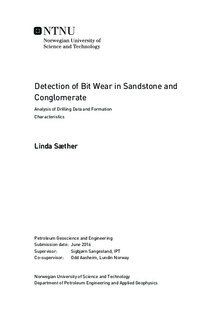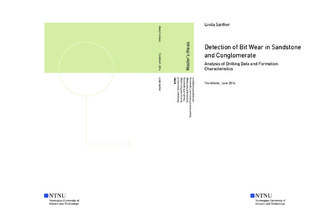| dc.description.abstract | When drilling in challenging formations the drill bit experiences wear to some extent, which may lead to a reduced rate of penetration. Since the drilling costs are so high, it is desirable to be able to detect bit wear in order to make actions to optimize the drilling process, extend the bit life and bit runs.
The aim of this master thesis was to investigate whether drilling data and formation data could be used to detect bit wear when drilling sandstone and conglomerate intervals. If trends and patterns were recognized in the data available, the results could be used to investigate and detect bit wear when drilling other wells, which could optimize the drilling process.
The calculations and evaluations performed are based on the statement that a higher weight on bit needed in order to achieve the same rate of penetration when drilling the same formation characteristics, is an indication of bit wear. Another statement expressed by drilling engineers and geologists in Lundin Norway, was that the bit experiences more aggressive wear and more drilling related problems when drilling conglomerate sections compared to sandstone. Drilling data and formation data from two productions wells at the Edvard Grieg field was used to investigate whether these data are sufficient in order to detect and recognize bit wear according to these statements.
After evaluating the reservoir sections in both wells, the same trends and patterns were detected. When the bit was worn, the weight on bit needed to be higher in order to achieve the same rate of penetration. The investigation also confirmed the statement that the drill bit experiences more aggressive wear when drilling conglomerate sections compared to sandstone. Therefore, it was concluded that drilling data and sub-surface data are sufficient in order to be able to detect bit wear. Since the patterns in the two wells are so evident, it was concluded that these evaluations and results are applicable in other wells when drilling the same lithology.
The results presented could potentially be used when optimizing the drilling process of other wells. If the same trends detected through this evaluation are recognized in a new well, the bit can be pulled earlier which could result in an overall higher rate of penetration and a more stable drilling process.
In the future, the industry should strive to optimize the way of drilling challenging conglomerate intervals, to extend bit life. Analysis of downhole drilling data should preferably be performed in order to find a more effective way of drilling such intervals. Investigation of more wells could be used to validate the results from the investigations performed in this thesis. | en |

